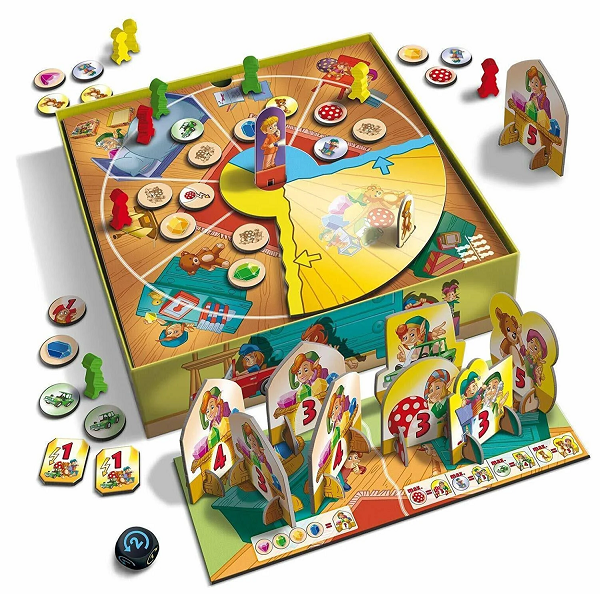Steal Toys and Collect the Loot in Family Game Kobold

You’re a group of mischievous kobolds, sneaking into Maurice’s room to steal toys and valuable gems. Don’t get caught in the beams of his flashlight or you’ll have to flee empty-handed.
Published by Queen Games, Kobold is a 20-minute game for 2-4 players, intended for ages 6 and up. But can adults enjoy it, too?
Gameplay
The board features a circle divided into seven wedges. The flashlight board swirls around this circle during the game, covering up two of these wedges at any time. Each wedge has 2-3 spaces for tokens, indicating if they should be placed face-up or face-down. At the start of the game, you fill all the spaces on the board except those in the wedges covered by the flashlight.
Each player has three kobolds in his player color. On your turn, you may either place one of your kobolds or retrieve all of your kobolds. When you place a kobold, you choose one of the wedges to put him in. You can never have more kobolds of your color on a wedge than there are tokens there, but this does not include other players’ kobolds.
When you retrieve your kobolds, you take back all of your kobolds that are present on the board, choosing the order. Each time you take one back, you choose one of the tokens present on that wedge. You then place the token face-up in front of yourself. Once you have taken all your kobolds back, you roll the die. This determines if the flashlight board moves 1-2 wedges left or right, or simply stays put where it is. If the flashlight board moves onto a wedge where there are kobolds, those kobolds are returned to their owners and do not take any tokens with them. Once you have finished resolving the die, you then refill any empty spaces on the board with new tokens.
There are five different types of tokens. There are toy tokens of different toy types. There are flash tokens, each of which indicates a type of toy. When one of these is drawn you check who currently has the most of that toy type and he earns two point tiles (if there is a tie then both players earn one point tile). There are kobold tokens which are each worth one point. Finally, there are gem tokens. Gems come in four different colors. When you manage to collect a set of each of the four gems, you discard them and claim the highest point value gem trophy still available.
The game ends once all the gem trophies have been claimed or there are not enough tokens left to refill the board. You then check who currently has the most of each type of toy and that player earns that toy’s trophy. The different toy trophies are worth different amounts of points. You then add up all your points and the player with the most points wins.

Review
Kobold is a fun, light set collection game with a sprinkling of press-your-luck and take-that elements. There’s always one wedge that is safe from being hit by the flashlight on the next roll, but sometimes those tokens that are closer can be quite tempting. You can even collect your kobolds early, triggering the die roll, in an attempt to knock an opponent off a space and prevent him from collecting an important tile.
The different tokens offer different ways to score, and there’s a lot of player interaction and adapting your plans based on what an opponent does. Perhaps you want to make sure you have the majority of teddy bears? Meanwhile, the gems can be worth a lot of points, but do you want to go after them and risk your opponent collecting more teddy bears than you? And grabbing a face-down token is always a risk but it might provide you with exactly what you were looking for.
It’s certainly light gameplay but is surprisingly engaging, and the component quality is pretty good, with the flashlight board being easy to set up each time, and easy to rotate around the circle.
The game box does say ages 6 and up, and it does feel like a game that is more targeted at families and children. But that does make the take-that nature of the gameplay a little more problematic, as I can imagine arguments resulting when someone purposely tries to knock off someone else’s kobolds by triggering a die roll. It’s likely to be subjective from family to family how comfortable you are with this. But it’s a cute, fun theme, scoring is simple but offers some interesting choices, and we enjoyed our time with it.
Pros: Scoring system offers some fun choices, good production quality
Cons: The take-that element may be a little strong for some families
Disclosure: we received a complimentary review copy of this game.






